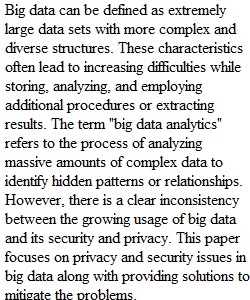


Q Introduction A research paper is a type of academic writing that provides an in-depth analysis, evaluation, or interpretation of a single topic, based on empirical evidence. The objective of the research paper is to provide a comprehensive work that thoroughly demonstrates the author’s understanding of the subject they researched. Every research paper is formulated around a thesis statement—the statement in the opening paragraph that states the author’s position and summarizes their supporting arguments. Research Paper Topics The topic of the research needs to address Big Data or Data Analytics. You are free to select a topic that you find most interesting. Some examples could be: 1. Security and/or Privacy Issues in Big Data 2. Machine Learning 3. Tools and software for processing Big Data 4. Big Data in Heath care or Retail 5. Big Data Quality and Governance Paper Logistics 1. 2 to 3 pages in length 2. Use APA format 3. Avoid using direct quotes. Paraphrase! 4. Ensure that information is properly attributed to works cited. Generally, in a research paper, most of the information should be cited 5. Avoid first person and passive voice 6. Check and double check your grammar and spelling Structure of a Research Paper 1. Introduction that clearly states the thesis and aims of the work. Using what you found in your preliminary research, write a thesis statement that succinctly summarizes what your research paper will be about. This is usually the first sentence in your paper, making it your reader’s introduction to the topic. 2. Body - Position/finding/challenge supporting the thesis 1. Supporting content 2. Supporting content 3. Conclusion - The conclusion of a research paper restates the research, summarizes your arguments or findings, and discusses the implications. In constructing the body of the paper, you may consider developing your paragraphs using the MEAL plan. Well-organized paragraphs guide readers logically through a paper's development, adding to the effectiveness of the argument and the credibility of the writer. Paragraphs vary in length and structure based on context, but they should focus on only one idea. Most paragraphs also include the following elements: a statement of the paragraph’s main (M) idea, evidence (E) to support that main idea, analysis (A) of that evidence, and some link (L) to the paper’s thesis. The MEAL Plan is an easy, effective strategy to help you organize paragraphs. • MAIN IDEA - All paragraphs should have a main idea or point. Typically, this main idea is expressed in a topic sentence - a sort of mini-thesis statement for the paragraph. Often, a topic sentence is the first sentence of the paragraph, though it may come after or within a transition statement. • EVIDENCE/EXPLANATION/EXAMPLES - This next section of the paragraph elaborates on the main idea. Depending on the type of assignment, the paragraph might require one or more of these “E”s: o Evidence—What does the main idea of the paragraph need to support it? Make sure to cite outside information. o Explanation—Do you need to explain key terms, concepts, or events? What information in the paragraph may be especially complex or unclear? o Examples—Other main ideas are best suited to examples, either from personal experience or research, to illustrate or highlight elements of the main idea. • ANALYSIS - Once the main idea has been stated and supported, it is time to break that information down and analyze it. What more do your readers need to understand about the evidence or examples you provided? How can you make it clear that you are interpreting this information in a certain way? In other words, this is the section of the paragraph where the HOW? WHY? or WHO CARES? of your evidence is explained. • LINK - Linking refers to the link between a paragraph and the paper’s thesis. Ask yourself how does this paragraph contribute to the overall effectiveness of the paper? You may not end up including that answer as part of the paragraph, but you must make sure you have made the connection clear. Too often writers assume readers automatically will recognize the link on their own, but your job as a writer is to make it impossible for a reader to miss how each paragraph supports your overall goal for the paper. Think about this connection to your thesis as a way to develop a smooth transition to the next paragraph. Rubric BIS245 Technology Research Paper BIS245 Technology Research Paper Criteria Ratings Pts This criterion is linked to a Learning OutcomeContent • The assignment defines the research paper clearly. • The assignment provides background information related to problem domain. • The assignment provides sufficient information in the description of the technology application to solve a business problem. 66 pts Full Marks The research paper provides all the content requested in this rubric category. 0 pts No Marks 66 pts This criterion is linked to a Learning OutcomeOrganization/Development • The paper provided an Introduction section or Abstract to concisely present and introduction to the paper contents. • The body of the paper was organized logically in sections. • The paper provided a conclusion/summary section 22 pts Full Marks The research paper provides organization to the reader clearly specifying titles and subtitles for the sections in the paper. 0 pts No Marks 22 pts This criterion is linked to a Learning OutcomeMechanics • The assignment is consistent with APA guidelines as directed by the facilitator. The assignment is laid out with effective use of headings, font styles, and white space. • Rules of grammar, usage, and punctuation are followed; spelling is correct. 22 pts Full Marks The research paper follows the mechanic guidelines specified in the rubric; provides APA references for assertions made in the content. It has a References section. 0 pts No Marks 22 pts Total Points: 110 PreviousNext
View Related Questions